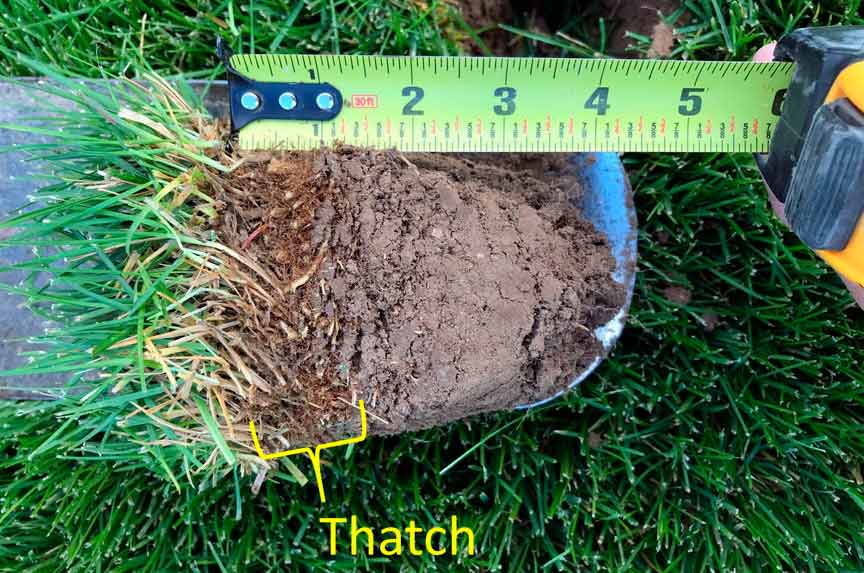Core Aeration of Lawns – Benefits and Procedures
The Problem
Two issues that commonly reduce the health and attractive appearance of a lawn are soil compaction and the development of a thick thatch layer. Both concerns reduce water and oxygen availability in the top layers of the soil, reduce water infiltration, limit root development, and make the turfgrass more prone to insects and diseases. Core aeration is a technique for reducing compaction and managing thatch development, a process that will help create a more attractive and healthy lawn.
Core aeration should not be confused with power raking (dethatching) or spiking (drum rollers with solid tines). A core aerator uses hollow tines to remove small-diameter soil plugs as the equipment moves across the lawn (Figures 1–3). This process creates air pockets in the soil and places soil residue on the surface, which then helps break down thatch. This is a much more effective way of dealing with both compaction and thatch than either power raking or spiking.
What is thatch?
It’s a mixture of living and dead roots, shoots, stems, and leaves that form on the surface of the soil, becoming part of the growing medium for the turf (Figure 4). Up to half an inch thick of thatch on a lawn is relatively harmless and thus okay.

at a glance
Benefits:
• Reduces compaction and helps degrade thatch layers.
• Improves infiltration of air and water into the lawn.
• Stimulates root growth and reinvigorates the lawn.
Procedures:
• Use a core aerator rather than a spike aerator or power rake.
• Aerate the lawn in the fall, but early spring is an acceptable alternative.
• Make two passes over the lawn, in perpendicular directions.
• Leave the aerator cores on the surface of the lawn when finished.




How Do I Core Aerate?
Prepare the lawn by irrigating about two days prior to the aeration operation. If you have an underground sprinkler system, mark all sprinkler heads so they can be avoided during the process. Obtain a hollow-tine core aerator. Small units are motorized and self-propelled. Larger units are designed to be towed by a lawn tractor. Set the tines to penetrate the soil to a depth of at least 3 in. Cover the lawn twice with the second pass perpendicular to the first. Once complete, core aeration will leave soil cores on the surface. Allow them to break down on their own or rake them into the grass. Do not remove them, because the cores will help break down thatch and return nutrients to the lawn.
When Should I Aerate?
The optimum time for core aeration in Idaho is the fall. A late-season aeration will minimize weed invasion due to soil disturbance and allow rapid recovery of cool-season turfgrass species during this season of fast growth. Alternately, core aeration can be done in the spring when rapid growth provides quick recovery. Weed invasion will be more of a problem in the spring. Core aeration should be avoided in the summer when cool season grasses are under heat stress and recovery from damage is slow.
How Often Should I Aerate?
On a typical lawn, core aeration should be done annually. Lawns with serious compaction problems, from heavy foot traffic or heavy clay soil plantings, may require core aeration two times a year.
Addition of Organic Matter
Once a lawn is in place, it becomes difficult to incorporate organic matter as a way of improving soil health. For a short period of time after core aeration, composts and manures can be successfully applied and incorporated into the resulting holes, thus improving soil tilth. Simply apply small-particle composted materials or manures on the lawn and rake the lawn to drag the organic matter into the core holes.
Can I Do It Myself?
Lawn aeration can be done by professional lawn-care companies. Alternately, you can purchase a lawn aerator or rent one at a local rental outlet. For most homeowners, renting a machine is the best choice, given that core aeration is scheduled infrequently.
Additional Reading
Rogers, Marilyn, ed. Ortho’s All About Lawns. Des Moines, IA: Ortho Books, 1999.
Turgeon, A. J., Turfgrass Management. 6th ed. Upper Saddle River, NJ: Prentice Hall, 2002.
About the Authors
Thomas Salaiz—NA Manager (McCain Foods), New Variety Deployment and Seed Supply, Burley, Idaho
Stephen L. Love—Professor, Aberdeen Research and Extension Center, University of Idaho Extension
BUL 964 | Published February 2020 | © 2022 by the University of Idaho












